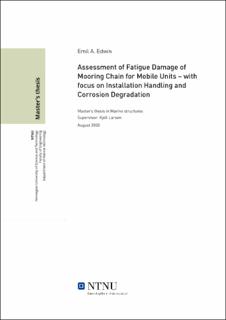| dc.description.abstract | Today’s fatigue limit state (FLS) design curve for mooring chains is produced by DNV-GL in form
of a SN-diagram based on Noble Denton testing. Noble Denton’s testing is performed on small
dimension chain (76mm) and all tests are run with 20% MBL mean load. The design curve do not
take into account what mean tension the chain in reality experience, but instead only rely on the
stress range. The design curve accounts for corrosion in the form of cross section area loss of link
(can be formulated as diameter loss).
Most mooring chains usually operate with a mean tension between 5-18% MBL, as a result it is
reasonable to ask if the mean tension has any impact on fatigue life. If it does, is it overly conservative
to assume 20% MBL mean tension in DNV-GLs design curves? In this thesis we have looked into
fatigue testing of new and used mooring chain (mainly performed by Equinor) to try and identify
factors that increase and decrease fatigue life of mooring chain which the DNV-GL SN-curve do not
include to a sufficient degree or at all.
Testing from the last decade strongly indicate that mean tension in a mooring chain have a big
impact on fatigue life. Tests run on used chain with various degrees of wear, corrosion and defects
have however shown outstanding fatigue performance when mean tension is lowered. Results indicate
that used chain (up to 25 years in operation) can perform just as well or even outperform the
results done by Noble Denton, when lower mean tensions are applied.
There has been universal agreement that corrosion has clear negative effect on fatigue life. Pitting
and MIC/SRB have been looked upon as the most compromising types of corrosion as they
leave sharp geometries and deep pits which is ideal for crack initiation. For MIC/SRB and pitting,
DNV-GLs way of accounting for corrosion with diameter loss is sufficient. But, studies also imply
that surface roughness from general corrosion might have a just as negative effect on fatigue life as
pitting and MIC/SRB, which cross section/diameter loss do not cover to a sufficient degree. Fatigue
assessments for AH OPS (52.6% MBL mean tension) performed in this thesis use LIFEMOOR’s
model to account for corrosion. These assessments showed that corrosion have a negative impact
on fatigue life, but parameter sensitivity testing pointed to corrosion as the least impactful parameter
w.r.t. fatigue damage. With an increase in fatigue damage of just 16.7% when comparing a
new chain to the most severe corrosion grade included in the NORMOOR model. These findings
indicate that today’s regime for fatigue damage adjustments due to corrosion might then be overly
conservative, especially if not adjusted for realistic operational mean tension.
It is not unusual for mooring chain for mobile units to be deployed and retrieved several times
annually. As a part of the of the deployment procedure, the anchor fastening and chain is to be
tested with a of 52.6% of the chains MBL (DNV-GL). The magnitude of this test load is often much
larger than what the anchor and lines will experience before being retired or break. The test is
performed by anchor handling vessels and when the load is applied, the chain will be in contact
with fairlead and the stern roller of the anchor handling (AH) vessel. Finite element analyses (FEA)
showed that peak stress location switched from chain link crown section for a straight chain, to mid
straight section for chain over stern roller. The chain over stern roller saw an increase in peak stress
of 15.6%. While a stress increase of just 15.6% might seem small, parameter sensitivity testing
performed in this thesis showed that chain/stern roller contact increased fatigue damage by 54.5%,
with other test parameters for chain and AH operation (OP) being close to optimal. Vargas, Hsu
and Lee (2004) [29] suggests that stress concentration factors (SCFs) do not change to a significant
extent with an increasing load. So in quantifying the SCF for chain over stern roller, simulations
in Abaqus was run with only 10% of MBL and did not see any stresses exceed material yield. This
was done to save computational time and get cleaner results. | |
